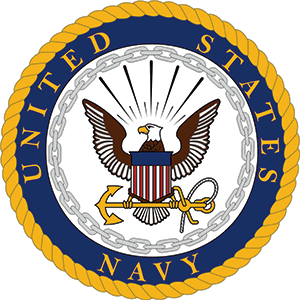The secrecy of the Manhattan Project meant that the U.S. Army and its affiliate, the U.S. Army Air Forces (not made a separate military branch until 1947), was the only branch officially charged with overseeing it. Nevertheless, the U.S. Navy would also play a crucial role in the project’s success.
Organization
Prior to the official creation of the Manhattan Project, the early stages of atomic research were managed under the joint control of the Army and the Office of Scientific Research and Development (OSRD), while the Navy was for the most part excluded. This order came directly from President Franklin Delano Roosevelt, who instructed Vannevar Bush to leave the Navy out of official Manhattan Project planning in an attempt to protect the project’s secrecy.
Nevertheless, afraid that the project would get stalled behind other military priorities, Bush suggested the creation of a Military Policy Committee (MPC). The three-person committee was created in September 1942 with Bush representing the OSRD (James Conant was his alternate), Lieutenant General Wilhelm Styer representing the Army, and Rear Admiral William Purnell representing the Navy.
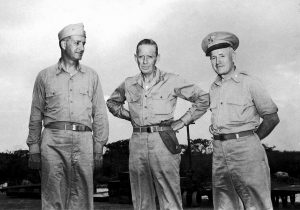
Parsons, Purnell, and Farrell.
Purnell would also represent the MPC and the Navy on Tinian Island in 1945. He was charged with keeping knowledge of Manhattan Project secrets from the Navy, but he also had the authority to transfer specific officers to become part of the project. Most notably, Purnell arranged for the transfer of Captain William “Deak” Parsons, a naval ordnance expert who had earned a reputation at the Naval Research Laboratory as an officer who could work well with scientists.
Parsons became the head of the Ordnance Division at Los Alamos. J. Robert Oppenheimer later objected to the portrayal of the Ordnance Division as of minimal importance in the first draft of the post-war Smyth Report: “[The Ordnance Division] had, and still has, the all-important and difficult job of making a weapon of this thing, of fuzing and designing it in such a way that it can be used in combat and can be effective” (Christman 206). Parsons would also serve as the weaponeer on the Enola Gay, where he armed the “Little Boy” uranium bomb in flight before it was dropped on Hiroshima.
The S-50 Plant
Despite being officially excluded from the Manhattan Project, the Navy still conducted its own research on nuclear reactors for possible use in ships and submarines. As early as 1939, physicist Ross Gunn proposed using uranium for “submarine submerged propulsion” so that it “would enormously increase the range and military effectiveness of a submarine” (Christman 212).
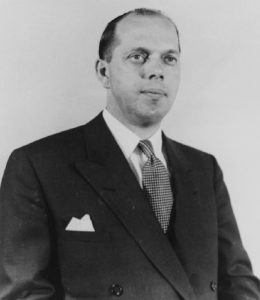
Philip Abelson
Navy research on uranium was set up at the Naval Research Laboratory (NRL) in Washington, D.C., under the leadership of physicist Philip Abelson. NRL researched the use of liquid thermal diffusion as a method of uranium enrichment. (Manhattan Project scientists had by this point decided that electromagnetic separation and gaseous diffusion were more effective, but due to the lack of information flow to the Navy, NRL was not aware of this.)
NRL soon designed a 36-foot tall thermal diffusion “column” which contained three pipes built inside of each other. As Abelson explained, “The apparatus was run continuously with no shut down or break down what so ever. Indeed, so constant were the various temperatures and operating characteristics that practically no attention was required to insure successful operation. Many days passed when in which operating personnel did not touch any control device” (Rhodes 550). In 1943, Abelson ordered the construction of a 300-column pilot plant, though only 100 columns would be built, at the Naval Boiler and Turbine Laboratory at the Philadelphia Navy Yard.
Abelson soon heard that the uranium enrichment plants at Oak Ridge were far behind schedule, so he sent word to Oppenheimer at Los Alamos about the success of the thermal diffusion design. Although the uranium produced at Philadelphia could not be used in a bomb, Abelson suggested that it could be used as a “feed” for the K-25 and Y-12 enrichment plants at Oak Ridge. By starting with uranium that was already slightly enriched, the entire process could be expedited.
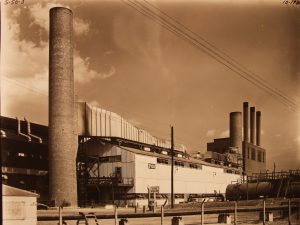
S-50 steam plant.
General Leslie Groves later remembered, “Dr. Oppenheimer suddenly told me that we had [made] a terrible scientific blunder. I think he was right. It is one of the things that I regret the most in the whole course of the operation. We had failed to consider [thermal diffusion] as a portion of the process from the whole” (553). Groves ordered the construction of a 2,100-column thermal diffusion plant at Oak Ridge, using Abelson’s plant as a model. Abelson recalled Groves ordered “a Chinese copy of what they have at the Philadelphia Navy Yard.”
Construction was contracted to the H. K. Ferguson engineering firm and was completed within Groves’ deadline of 90 days, a process made easier by the power plant that already existed in Oak Ridge. The new plant was code-named S-50 (in Groves’ office it was known as “Fox’s Farm” after Lt. Col. Mark C. Fox, who was put in charge of it).
As Abelson later remembered, “It did make something of a difference. I think Congressional testimony ultimately said that it shortened the war by seven days. It was at a cost of twenty-five million dollars, and the cost per day of the war was approaching something like a billion dollars, plus the number of lives lost and so on. It made a difference. Not an enormous difference, but it made a difference.”
The plant at the Philadelphia Naval Yard was the site of a fatal accident in September 1944. During repairs, a clogged tube shattered and the liquid uranium hexafluoride inside it combined with the escaping steam, showering workers with hydrofluoric acid. Two engineers died; a third, Arnold Kramish, survived but suffered severe burns. Due to the secrecy of the Manhattan Project, a press release on the incident was entitled only “Explosion at Navy Yard.”
Project Camel
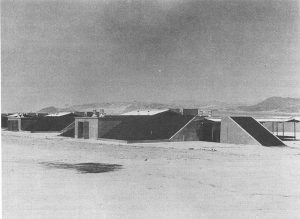
The Salt Wells Pilot Plant in 1946.
In November 1943, the Navy established the Naval Ordnance Test Station (NOTS) at Inyokern, California, in the Mojave Desert. Under the auspices of the Office of Scientific Research and Development, it initially contracted the California Institute of Technology to work on aircraft ordnance and the production of rockets (as a response, in part, to the German development of the V-2 rocket).
In early 1945, NOTS began collaborating with the Manhattan Project under the codename Project Camel. One of their assignments was B-29 airdrops of model atomic bombs so that scientists could calibrate the drop path of the bombs accordingly. As the date of the Trinity Test neared, scientists also expressed the need for a high-explosive lens which would compress the plutonium in the Fat Man implosion bomb. The Los Alamos S-Site did have a production plant for high explosives, but as General Groves explained, “It was like one of these firecracker plants that you read of blowing up every once in a while” (Norris 321). Deak Parsons suggested building another plant at Inyokern. The Salt Wells Pilot Plant had to be running in 100 days, and it produced its first high explosives on July 25, 1945.
The USS Indianapolis
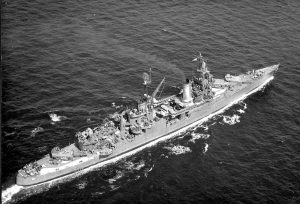
USS Indianapolis, seen from the air, 1945
The Navy would also play an important role in the transportation of the components of the “Little Boy” uranium bomb, which would be dropped on Hiroshima (“Fat Man” components were transported by aircraft). Little Boy’s “gun-type” mechanism and uranium were sent from San Francisco to Tinian Island aboard the USS Indianapolis, a Navy cruiser. The ship was placed under the command of Captain Charles McVay III. Manhattan Project staff James Nolan and Robert Furman accompanied the bomb parts onboard.
The Indianapolis set off for Tinian on July 16, 1945, shortly after receiving confirmation of the success of the Trinity Test. It traveled quickly, arriving safely on July 26. The bomb components were unloaded and reassembled on the island. The Indianapolis was subsequently sent to the Philippines, but was sunk by a Japanese submarine in the worst naval disaster in American history. To read AHF’s full article on the USS Indianapolis, click here.
Post-War Efforts
The Navy also played an important role in the post-war nuclear program. Deak Parsons had done research during the war on theoretical nuclear attacks on ships, including investigation into the 1944 Port Chicago disaster in which 320 sailors were killed after munitions aboard a cargo ship detonated. In 1945, Parsons formed the Navy Atomic Bomb Group, and began to push for tests of bombs above and below ships.
In 1946, Secretary of War Robert Patterson suggested a “cooperative approach by the War and Navy Departments on a program of engineering development of atomic power” (Christman 213). Although Manhattan Project secrets were still officially kept from the Navy, Parsons arranged for many Navy officials to be transferred to the project in order to receive security clearance.

The Able Shot of Operation Crossroads
The same year, the Army and Navy jointly conducted Operation Crossroads, a series of nuclear tests at Bikini Atoll in the Marshall Islands. As Parsons had imagined, the tests were designed to determine the effect of nuclear weapons on naval warships. They including some ships loaded with live animals, such as pigs and rats, to study the effects of the nuclear blast and radioactive fallout on animals.
Further research also took place at the Naval Ordnance Test Station at Inyokern, by this point known as NOTS China Lake. Parsons helped to develop Sidewinder, an infrared missile which could intercept a target aircraft. He also pushed for the development of nuclear submarines, as he “concluded that the possibility of nuclear power made it possible to build the true submarine” (235).
Admiral Hyman Rickover, known as “the Father of the Nuclear Navy,” became the Director of the Naval Reactors Branch of the Bureau of Ships in 1949. He was also assigned to the Division of Reactor Development of the Atomic Energy Commission. The United States launched its first nuclear submarine, the USS Nautilus, on January 21, 1954.
In the late 1950s, the United States also developed the Polaris missile, a submarine-launched ballistic missile (SLBM). Today, SLBMs make up one-third of the nuclear triad, with the other components being land-based ballistic missiles and strategic bombers. The goal of the triad is to ensure second strike capabilities (a retaliatory strike after a nuclear attack).





